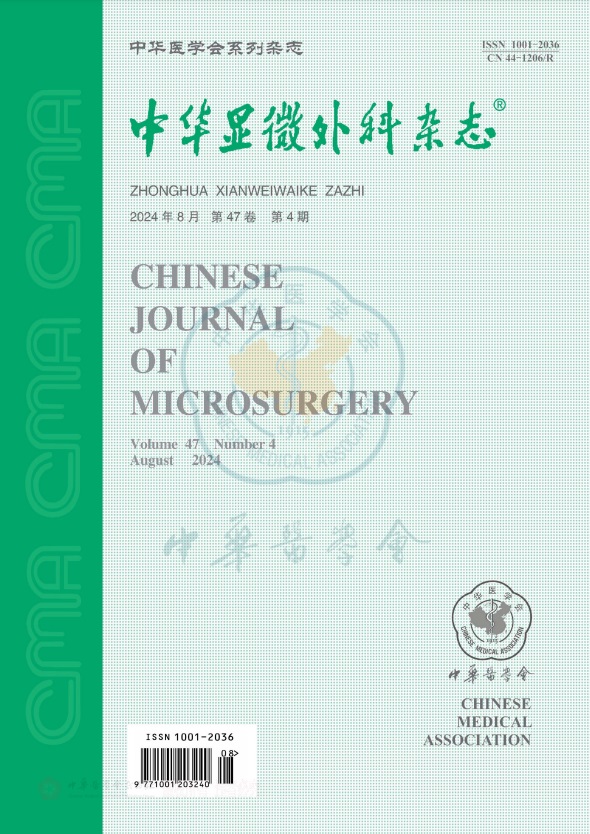Application of the bionic multi-channel nerve conduit in the rabbit sciatic nerve defect by reducing mismatch of regenerated nerve fibers
引用次数: 0
Abstract
Objective To investigate the role of the bionic multi-channel nerve conduit by reducing mismatch of regenerated nerve fibers in the rabbit sciatic nerve defect. Methods The experiment was conducted from July, 2017 to February, 2019. A total of 55 New Zealand white rabbits were randomly divided into two groups (First group, n=30 and Second group, n=25). There were 5 subgroups (n=6) in the first group, which were autograft and custom-anatomic nerve conduits (CANC) with different channel (1-CANC, 2-CANC, 3-CANC, 4-CANC) that implanted to repair the rabbit sciatic nerve defect (10 mm). The electrophysiological, triceps muscle wet weight recovery rate, histological study and ankle index analysis were used to evaluate the treatment of each group at 12 and 24 weeks postoperatively. There were 5 subgroups (n=5) in the second group. The simultaneous retrograde tracing method was applied to compare with the number of mismatched nerve fibers at 24 weeks postoperatively. All data were recorded and analyzed by One-way ANOVA method, the Turkey’s method was used to compare the differences between each subgroup. The difference was considered to be statistically significant if P<0.05. Results The autograft group showed the best recovery in the electrophysiology, histology study and ankle index at 12 and 24 weeks postoperatively (P 0.05), but diameters of nerve fiber and myelin thickness were higher in 2-CANC and 3-CANC [(10.67±0.56) μm,(10.65±0.53) μm, respectively] compared with 1-CANC and 4-CANC groups [(8.43±0.63) μm, (9.03±0.55) μm, respectively]. The differences were similar in electrophysiological, wet weight recovery rate of triceps muscle, histological study and ankle index analysis. Simultaneous retrograde tracing showed that the autograft group had highest total number of labeled profiles, but no significant difference of the total number of labeled profile was showed among the CANC groups. However, the 1-CANC group[(7.1±2.4)%] showed highest percentage of the FB-NY-neurons than other CANC groups[(2.7±1.9)% in 2-CANC, (2.5±2.3)% in 3-CANC, and(2.2±1.2)% in 4-CANC](P<0.05). Conclusion The autograft group showed the best results among all groups. Compared with the 1-CANC group, the 2-CANC and 3-CANC group obtained more mature regenerated nerve fibers and with a fewer mismatch rate. Moreover, that did not affect the number of regenerated fibers. Key words: Rabbit; Sciatic nerve defect; Nerve conduit; Bionic; Multi-channel; Regenerative nerve fiber mismatch仿生多通道神经导管减少再生神经纤维失配在兔坐骨神经缺损中的应用
目的探讨仿生多通道神经导管在减少再生神经纤维失配修复兔坐骨神经缺损中的作用。方法实验时间为2017年7月~ 2019年2月。选取55只新西兰大白兔,随机分为两组,第一组30只,第二组25只。第一组共5个亚组(n=6),分别为自体和自定义解剖神经导管(CANC),采用不同的通道(1-CANC、2-CANC、3-CANC、4-CANC)植入修复兔坐骨神经缺损(10 mm)。采用电生理、肱三头肌湿重恢复率、组织学研究和踝关节指数分析评价各组术后12周和24周的治疗效果。第二组共5个亚组(n=5)。术后24周采用同步逆行示踪法比较失配神经纤维数量。所有数据记录并采用单因素方差分析方法进行分析,比较各亚组间差异采用土耳其法。以P<0.05为差异有统计学意义。结果自体移植物组在术后12周和24周的电生理、组织学和踝关节指数恢复最佳(P < 0.05),但2-CANC组和3-CANC组的神经纤维直径和髓鞘厚度分别高于1-CANC组和4-CANC组[分别为(8.43±0.63)μm,(9.03±0.55)μm](分别为(10.67±0.56)μm,(10.65±0.53)μm]。在电生理、肱三头肌湿重恢复率、组织学研究和踝关节指数分析方面差异相似。同时逆行示踪显示自体移植物组有最多的标记谱数,但不同CANC组间标记谱数无显著差异。而1-CANC组的fb - ny神经元比例为(7.1±2.4)%,高于其他CANC组[2-CANC组为(2.7±1.9)%,3-CANC组为(2.5±2.3)%,4-CANC组为(2.2±1.2)%](P<0.05)。结论自体移植物组疗效最好。与1-CANC组相比,2-CANC和3-CANC组获得了更多成熟的再生神经纤维,错配率更低。此外,这并不影响再生纤维的数量。关键词:家兔;坐骨神经缺损;神经导管;仿生;多通道;再生神经纤维不匹配
本文章由计算机程序翻译,如有差异,请以英文原文为准。
求助全文
约1分钟内获得全文
求助全文
来源期刊
CiteScore
0.50
自引率
0.00%
发文量
6448
期刊介绍:
Chinese Journal of Microsurgery was established in 1978, the predecessor of which is Microsurgery. Chinese Journal of Microsurgery is now indexed by WPRIM, CNKI, Wanfang Data, CSCD, etc. The impact factor of the journal is 1.731 in 2017, ranking the third among all journal of comprehensive surgery.
The journal covers clinical and basic studies in field of microsurgery. Articles with clinical interest and implications will be given preference.

 求助内容:
求助内容: 应助结果提醒方式:
应助结果提醒方式:


